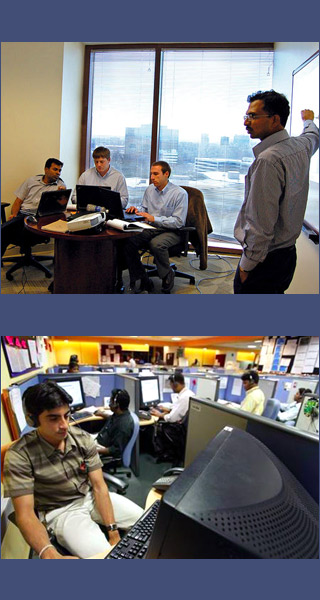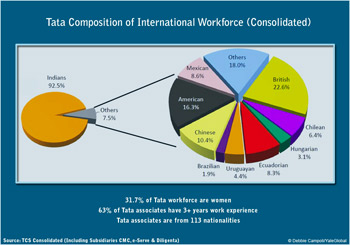Amid US Outsourcing Fears, India’s IT Firms Thrive
Amid US Outsourcing Fears, India’s IT Firms Thrive

WASHINGTON: President Barack Obama’s 2008 election worried India’s offshore outsourcing industry, after a campaign where he repeatedly called on the US to “stop giving tax breaks to companies that ship jobs overseas.” The theme returned this year, with Obama using outsourcing against his Republican challenger, Mitt Romney. For the offshore IT industry, particularly in India, it’s déjà vu.
India’s IT industry is vulnerable to US policy. To perform jobs outsourced by US companies, it needs large numbers of temporary work visas, the H-1B visa especially. Many in the industry worried – for naught – that an Obama presidency might bring work-visa restrictions.
Bangalore-based Infosys Ltd., for instance, got approval for nearly 4,600 new H-1B visas in 2008. The next year, the company told investors in an SEC filing that it had 8,200 workers on H-1B visas, the majority of its US-based technology professionals. One month after the 2008 election, Wipro Ltd., another large Indian IT firm, warned investors of the potential for “disincentives” on visas because of increasing political attention on outsourcing. Wipro had received approval for nearly 2,700 H-1B visas in 2008.
India’s Finance Minister P. Chidambaram tried to ease concerns, telling reporters shortly after the election, “Once Obama is in office, he will realize that it is an interconnected world, and countries have to work together."
Chidambaram’s assessment has proven to be accurate, but the Obama administration’s stance was helped by the recession.
Lingering effects of the global recession starting in 2008 softened demand for H-1B visas and made outsourcing less of an issue politically. More importantly, the Obama administration made increasing exports a key part of its recovery plan and didn’t want to poison India as an export market for US firms. Any action to restrict temporary work visas risked charges of protectionism and the possibility of trade repercussions. India’s IT firms grew unabated in Obama’s first term.

In its 2008 fiscal year, for instance, Tata Consultancy Services in Mumbai employed 143,000, with approximately 51 percent of its revenue coming from North America. It now gets nearly 54 percent of its revenue from North American firms and employs 238,538, according to SEC filings. Of TCS’s global workforce, it describes 92.5 percent as Indian, with the composition of the remaining 7.5 percent including 22.6 percent British, 16.3 percent American and 10.4 percent Chinese.
In terms of visa use, Infosys this year reported in government filings that it had 10,115 employees in the US on H-1B visas, or 23 percent more than when Obama was elected.
In the fall of 2010, Obama met with Indian government leaders and CEOs in Mumbai and told them that “U.S. economic success, U.S. job creation, U.S. economic growth is going to be tied to our working with, cooperating with, establishing commercial ties with the fastest-growing economies in the world.”
Rising export numbers were behind Obama’s view. In 2010, the White House said that merchandise exports to India quadrupled between 2002 and 2009, surpassing $16.4 billion and growing at 18 percent annually. Exports were a priority.
But rising exports with India won’t necessarily protect the offshore industry from Congress, which controls the annual H-1B cap, now set at 65,000, with another 20,000 set aside for foreign nationals who earn advanced degrees in science, technology, engineering or math.
The Indian IT industry doesn’t have to lobby for increasing the H-1B cap. It outsources that work to the US industry, which says the cap constrains its ability to hire talent. Critics of temporary and permanent employment-based visa caps include Microsoft’s Bill Gates and Google’s Eric Schmidt. Schmidt served on the Obama transition team and remains a White House science and technology adviser.
Because of unemployment rates exceeding 8 percent, Congress hasn’t tried to raise H-1B cap since 2008. Obama, meanwhile, has sent out three interrelated messages about offshore outsourcing:
To the broader domestic audience, Obama continues to attack offshore outsourcing, but consistently frames it as a tax-code issue. Tax-code adjustments are not viewed as a serious threat to the industry. For the US IT industry, Obama calls for support for permanent residency for foreign students who earn advanced science, technology, engineering and math degrees from US universities. “As soon as they obtain advanced degrees, we send them back home to compete against us,” Obama said last year. “It makes no sense.” Politically, permanent visas are an easier sell with Congress than temporary visas.
For the Indian audience, Obama delivers a message about, as Chidambaram suggested, an interconnected world.
Similar to Obama, Romney supports permanent residency for students earning advanced science and engineering degrees at US universities. On temporary work visas, Romney wants to raise the caps for advanced degree holders. Obama has said little about the temporary program.
Many in the IT industry live in Blue States, the West Coast and Northeast, and campaign donations favor Obama. But the industry, certainly its lobbying and policy groups, tries not to show a preference for either candidate.
Tension remains in Congress about H-1B visas, posing risk for Indian firms.
In 2010, New York Senator Chuck Schumer, who then headed the Immigration, Refugees and Border Security subcommittee, won approval for a $2,000 fee increase on firms that have 50 percent or more of their US employees on H-1B and L-1 visas. It was a direct attack on offshore firms; India’s government may pursue a World Trade Organization complaint. In defending it, Schumer said low-wage workers in the US were “discouraging many of our smartest students from entering the technology industry in the first place.”
Critics of the H-1B program argue that visa workers are often paid well below US workers, despite prevailing-wage requirements. US Representative Zoe Lofgren, who represents Silicon Valley, said in her district the average wage for a computer system analyst is $92,000, but an H-1B worker can be paid about $52,000 under wage rules.
Computer science enrollments in US universities plummeted following the dot-com bust in 2001. Colleges blamed the evaporation of many e-commerce startups and fears that offshore outsourcing was jeopardizing many jobs.
Just after the dot-com bust, in 2001-02 the number of bachelor degrees awarded in computer science and computer engineering at US PhD-granting institutions was nearly 21,000. By 2008-09 it had declined by more than half, according to the Computing Research Association’s annual survey. Degree rates are now rising, expected to pass 12,000 this year. The 2008 recession, which reduced the attractiveness of financial services for math-inclined workers coupled with a high demand for mobile app development, is credited with much of this enrollment growth.
What Indian firms fear most is a proposal by senators Dick Durbin and Charles Grassley that limits the number of H-1B or L-1 visas to 50 percent of the workforce for US firms with 50 or more employees.
Indian firms are trying to counter Durbin-Grassley by increasing the size of their US-based workforces. As they provide more sophisticated services, the firms say they need more onsite customer contact. It’s too early to know how significant the trend is. Some of the increased presence may simply reflect their overall growth.
With offshore outsourcing under attack at the recent Democratic National Convention, Laura Tyson, the former Clinton administration chair of the Council of Economic Advisors and an advisor to the Obama campaign, was meeting with the foreign press. She talked about offshore outsourcing and told reporters: “I actually think it is important to recognize that insourcing, outsourcing, supply chain complexity, supply chain disaggregation, is here to stay.”
Tyson’s soothing message, a transcript of which is posted on the US Department of State website and widely noted by India news media outlets, went unnoticed by US news media. In India, The Economic Times proclaimed, “Outsourcing is here to stay: Barack Obama aide.”
Patrick Thibodeau is a senior editor at Computerworld covering the intersection of public policy and globlization and its impact on IT careers. He also writes about high performance computing, data centers including cloud, and enterprise management.